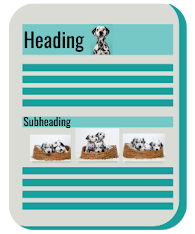This post includes SPOT Tips from Assistant Distance Learning Coordinator & SPOT Facilitator Catherine McKee.
TRUE or FALSE: The best way to create headings in Canvas is by adding formatting to the heading text such as bold, underlining, or typing text in all capital letters.
The answer is False! Read on to learn more about our topic of the week: Headings!
Headings are not made by changing the look of the text using size and color. Even though your eyes may tell you this creates a heading, it does not actually structure the headings into the document and that is what is needed to create accessible headings. Heading Styles structure headings into a page or document. Using Heading styles is very similar to applying any other type of formatting to text–and luckily, it is just as simple!
The Why & How of Headings
Using built-in heading styles serves multiple functions. When a heading style is applied, the heading text doesn’t just “look” like a heading, its role as a heading is now baked into the page structure. Perhaps you’ve had this experience with Word documents: if you add heading styles and enable the navigation pane, you will see a heading outline structure that lets you click on headings and jump around in the document with ease. You are accomplishing something very similar for screen readers when you add heading styles to the headings in a Canvas page (or in a Word document). Screen reader programs only recognize headers when a header style is applied. This allows screen reader users to understand the importance level of the heading and to jump between headings to navigate the page or document.
Chunking with Headings
Headings remind us to “chunk” our content into manageably sized pieces. Proper use of Canvas heading styles is a SPOT requirement, but anyone who uses Canvas to deliver class content and resources (even classes that meet in a classroom) should know about Canvas headings and how to use them properly.
Luckily, the Faculty Accessibility Center (FAC) can help! Our friends at the Faculty Center for Learning Technology (FCLT) built the FAC as a Canvas resource for all who use Canvas in a teaching role. Enrolling in the FAC course in Canvas will place the course on your Canvas dashboard for easy access when you have accessibility questions. Think of it as a compliment to Canvas and SPOT.
Joining the Faculty Accessibility Center (FAC)
You can view content in the Faculty Accessibility Center without enrolling, but you may find it easier to find and use if you enroll in the FAC. Don’t worry! If you wish to unenroll at any time, instructions on how to do so are linked to the home page.
To see the Headings info in the FAC, go to the “Canvas Accessibility” module. Here you will find a Headings topic where you can learn how to use headings, more on why we use them, how to add them (with pictures!), and additional resources. Check out this short video, from the FAC, that gives a two-minute overview of several different ways to format headings in your Canvas content.
I learned something new. Did you? Properly formatting your Canvas headings is as easy as applying any other text formatting: once you know how to do it. Visit the FAC Canvas headings page any time you’d like to review how to make headings in Canvas…and while you are there, check out the other areas of accessibility, and the tools to implement them, in the FAC.
SPOT Deadline Reminders
Finally, we want to remind faculty currently working towards their SPOT certification of upcoming SPOT submission deadlines:
- For SPOT certification for summer 2021, submit your SPOT course and rubric by March 1, 2021.
- For SPOT certification for fall 2021, submit your SPOT course and rubric by June 1, 2021.
Remember, submission is not certification.
You earn certification when your course meets the SPOT course and rubric standards, as verified by your SPOT reviewer. The review process can take weeks or months depending on a variety of factors, so please submit your course for review as early as possible. SPOT certification may be required for faculty teaching online or hybrid courses as early as fall 2021. Check your email regularly for an update on this deadline.
- For SPOT questions contact Catherine McKee at cmckee@mtsac.edu.
- For SPOT sign-up questions please contact Sandra Weatherilt at sweatherilt@mtsac.edu.
- For information on SPOT: See the SPOT info page on the Mt. SAC website



